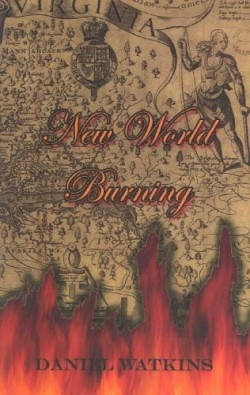
New World Burning
In 1676 Virginian aristocrat Nathaniel Bacon twenty nine raised a militia of 500 farmers servants and slaves — both black and white. Resenting the Royal Governor’s friendly policy toward Native Americans the men massacred peaceful tribes set the Governor to flight and burned down Jamestown. The insurrection ended suddenly with Bacon’s death and the subsequent hanging of forty followers. Jamestown descendant Daniel Watkins brings this explosive period to life in his second novel New World Burning.
Watkins uses fictional Philip Corstair to tell the story of Bacon’s rebellion. He traces Corstair’s arrival to Jamestown as an indentured servant his struggle for freedom and a farm of his own his friendships with Native Americans. When his loved ones are slaughtered Corstair is swept up in Bacon’s zealous plot only to regret his folly years later.
An energetic muscular novel New World Burning triumphs in its graphic depiction of harsh Colonial life. When Corstair arrives in Jamestown everything appears extreme to him: the weather (“the sky above us [was] blacker than a cave in the ocean exploded like an electrical terror”) the bugs (“relentlessly they pierced needling and tormenting delighting in my private-most places”) his love for a tough-minded woman (“how easy and how fragile I thought for a life to be taken by the lips of a lost love’s kiss”).
Watkins gives his story an epic cinematic scope. He balances gritty historically pinpointed details (like the smelly bear fat and mud used as bug repellant) with an exaggerated sense of drama. All miseries of the human condition — starvation slavery disease and mass murder vengeance and unreasoning fanaticism — throng in New World Burning. Because the book contains such high-stakes events it seizes the reader with a vigor and immediacy unusual for historical fiction.
The novel’s capable prose and rich setting move the story smoothly but the text can be difficult. The poorly punctuated dialogue frequent sentence fragments and misused commas distract the eye and mind. Furthermore Corstair talks to his Native American friends in untranslated Algonquin. Since Watkins modernizes the 17th-century English voice successfully a translation of the Native American conversations would only boost the novel’s realism.
New World Burning should draw history aficionados and lovers of war stories. As the title suggests the novel will immerse readers in a sensational view of early Jamestown infused with the drama of Watkins’ twenty plus years as an actor and grounded by his serious research.
Disclosure: This article is not an endorsement, but a review. The publisher of this book provided free copies of the book and paid a small fee to have their book reviewed by a professional reviewer. Foreword Reviews and Clarion Reviews make no guarantee that the publisher will receive a positive review. Foreword Magazine, Inc. is disclosing this in accordance with the Federal Trade Commission’s 16 CFR, Part 255.
